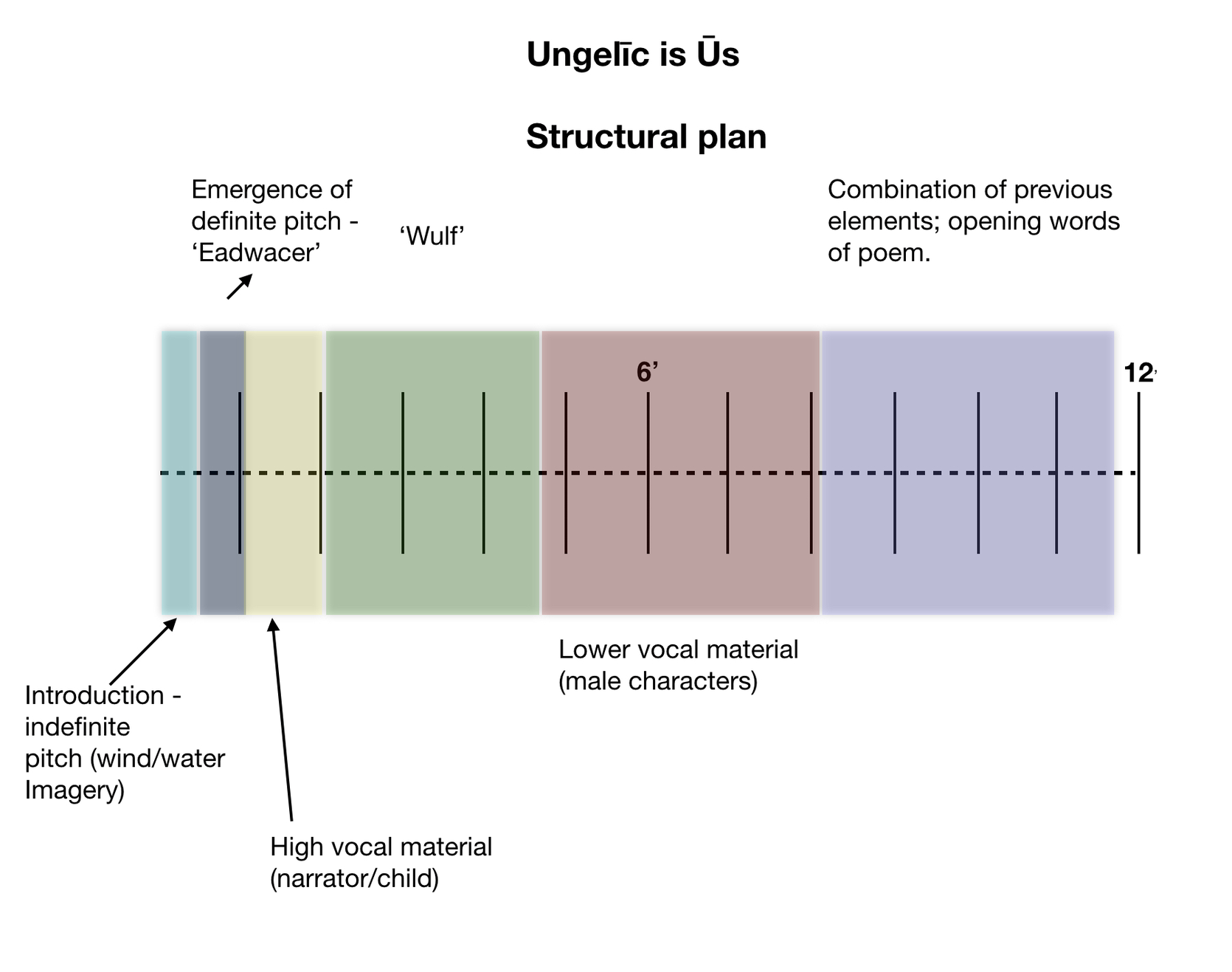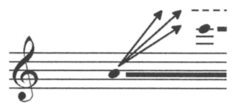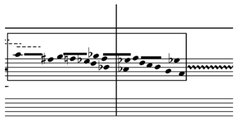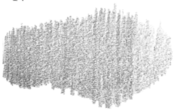Graphic score of Ungelīc is Ūs. The graphic score was created primarily for the electronics performer, prioritising information such as timings and pitch cues (to facilitate live diffusion of the quadrophonic version of this piece). Click to follow the score and hear the piece.
i) Layout
The score consists of a stave (for sounds of definite pitch) and a rectangular box (for sounds of indefinite pitch). Vertical lines are placed at intervals of five seconds. Noteheads and graphical symbols are spaced in proportional relation to their time span.
ii) Dynamics
General dynamics are placed between the rectangular box and the stave, or beneath the stave if space is limited. Dynamics that apply to a particular sound are placed as close as possible to the graphical representation of the sound.
iii) Definite Pitch
Sounds of definite pitch are represented by stemless noteheads on a stave, with thick horizontal lines indicating the duration of each pitch. All sounds of definite pitch are derived from samples of a singer’s voice. Many of these samples have been transposed and filtered in order to isolate particular partials. Consequently, the majority of these samples are not in equal temperament tuning. Microtonal pitches are notated as follows:
For intervals which deviate from equal temperament by more than approximately five cents but less than a quarter tone, a small upward- or downward-pointing arrow is attached to the natural, sharp, or flat sign, indicating that the pitch is slightly sharper or flatter than the pitch [n] to which the accidental is applied.
= less than c. 50 cents flatter than [n] natural
= less than c. 50 cents flatter than [n] flat
= less than c. 50 cents flatter than [n] sharp
= less than c. 50 cents sharper than [n] natural
= less than c. 50 cents sharper than [n] sharp
= less than c. 50 cents sharper than [n] flat
Up to this point, the methodology that gave rise to We Are Apart; Our Song Together had used the poem’s linear structure to suggest musical form. However, although this approach retained the integrity of the text, it overlooked the layered complexity of the narrator’s inner monologue as her thoughts move seamlessly between memory, contemplation of her present situation, and consideration of the future. I was fascinated by Bruno Bossis’s assertion that, in Luciano Berio’s Thema (Omaggio a Joyce), sonic phenomena generate long-range literary and musical processes, fulfilling a structural role rather than carrying exact meaning.1 My first research question, therefore, was simply to ask how I might free the text from its linear temporality, to consider it almost as though it were an object suspended in space. This approach was, in part, inspired by Pierre Boulez’s discussion of the varieties of musical commentary that might arise in response to a poem. Boulez proposed that ‘musically speaking there are two times, one for the poem as action and one for the poem as reflection’.2 To develop a structure that was less dependent on the order of the lines of the poem, I turned to the refrain's last line, ‘ungelīc(e) is ūs’. Using the spoken rhythm of ‘ungelīc is ūs’, the phrase was recomposed using a mixture of consonant and breath sounds, drawing on a technique that the composer Cathy Lane described as ‘melodic or rhythmic extraction, translation and elaboration’ in electroacoustic music.3 This created a motif akin to a non-semantic commentary on the poem’s refrain, heard at four points during the piece, at 30”, 1’01”, 1’59” and 8’06". This motif, together with markers such as a spoken or sung line of text, acts almost like a punctuation point before the introduction of a new section or idea in the music.
However, the mention of a sectional structure raises another fundamental research question. Given that the structure of We Are Apart; Our Song Together was determined by the order of the poem's lines, what would provide the structural framework of the new piece? Was a formal model even necessary or desirable to facilitate commentary on the poem? We Are Apart; Our Song Together had treated the text’s various strata of emotions, characters, and images as synchronous components of a single movement work. My subsequent decision to move beyond a sequential reworking of the poem gave rise to the idea of a temporal separation of the text’s strata. In attempting to free the text from its original time frame, I began to group the musical material according to its salient characteristics, such as definite and indefinite pitch, tessitura, and harmonic content. In my electroacoustic composition Ungelīc is Ūs, the different types of musical material are summarised using graphical symbols (which are explained in the key to the score). The process of trial and experiment ultimately led to the development of six main sections that reflect different aspects of the text’s thematic material.
At a purely symbolic level, the six sections correspond to the six syllables of the refrain in its second version, ‘ungelīce is ūs’. The introductory section (up to 32”) uses almost entirely sounds of indefinite pitch, based on recorded samples of the spoken and sung text which have been transformed to allude to the watery, windswept landscape in which the poem is set. The second section (up to 1’04”) introduces material of a definite pitch, based on a sustained G note, and presents the name of one of the poem’s principal characters, Ēadwacer. The third section (up to 2'03”) further develops material of definite pitch, based on spectral analyses of the singer’s voice, in general no lower than the pitch of the G below middle C and thus within the average range of a female or juvenile male voice. In this way, this section alludes to the character of the female narrator and the unnamed child. The fourth section (up to 4’42”) develops cycling melismatic phrases based on the word Wulf, the name of the text's principal male character. The fifth section (up to 8’08"), develops recognisably vocal material of a lower pitch, alluding to the voices of the poem’s male characters. The final section was a deliberate attempt to combine elements that had already been heard, while introducing new ideas such as the opening half-line of the poem (at 8’26”), definite pitch material based on the motif (from 8'30"), and repeated, recited lines of the poem (from around 10’56”).
However, is the division of a composition into seemingly arbitrary sections really an example of a commentary on a text? Can such a process even be described as commentary when the source text is itself obscure and unknown to all but a handful of literary specialists? In Ungelīc is Ūs, the division of material into sections is perhaps more understandable as an underlying structural principle, rather than something that will have direct relevance to the listener’s interpretation of precise words and phrases. It is a subjective response, one of many other possible solutions to the research questions posed during the process of this project. In each section of the composition, samples of vocal material are transformed into different pitches and timbres to suggest a proliferation of voices. However, the material keeps returning to the relatively unaltered voice of the solo mezzo-soprano. At a structural level, the arrangement of different types of material was intended to highlight the duality of presence and absence, desire and abhorrence, nostalgia and regret that pervades the text, summarised by the contradictory sense of separation and intimacy in the poem’s final two lines.
The central issue of commentary draws attention to another issue regarding Ungelīc is Ūs. All of the sung material is taken from the vocal line of We Are Apart; Our Song Together. Some vocal phrases and some of the sounds reminiscent of water or wind are therefore duplicated, shared between the two pieces. As in We Are Apart; Our Song Together, stereo panning is used to create a sense of movement and distance between different sounds. In a subsequent, quadrophonic version of Ungelīc is Ūs, voices frequently seem to move in a circular motion around the listener, drawing attention to the centrality of the listener's experience. However, given the evident similarities between the two works, Ungelīc is Ūs could also be understood as a commentary on the previous composition for voice and tape. The idea of a dialectical relationship between the two works is further implied by the way in which they are presented together in this exposition.
However, the discussion of commentary from the composer's perspective risks implying a causal link between artistic decisions and the listener’s experience. Repeated listening during the creative process can blunt the composer’s perception of a sound’s emotional and extra-musical connotations, creating a potential rift between composer and audience. Indeed, one of Jean-Jaques Nattiez’s key criticisms of Schaefferian reduced listening is that it is essentially creation rather than interpretation, describing the type of listening that is undertaken by a composer when assembling sounds into a work.4 In contrast, Gary Kendall’s discussion of the listener, focusing on the ways in which feeling and emotion can contribute to multi-layered interpretations of an electroacoustic work, draws attention away from creation towards reception.5 In the process of my creative practice, Kendall’s idea of the listener’s ‘mental layers’ of electroacoustic music suggested parallels with the layered nature of the Old English poem, and its potential for multiple, overlapping, divergent interpretations.6 However, the variety of approaches that have informed my practice suggest that different theories of listening and meaning need not be mutually exclusive. The web of relationships between voice and listener, meaning and interpretation, and sound and source, is conducive to a multilayered lattice of different theories and explanations. Istvan Anhalt drew attention to the complex relationship between composer, interpreter, listener, and questioner in vocal music, noting that ideas of meaning and interpretation often overlook the potential differences between the knowledge, traditions and affective space of each of these roles.7
As I developed my approach to commentary in light of these ideas, the listener became the nodal point within a complex system of relationships that linked the Old English poem with the electroacoustic vocality of my compositions. The work of Nina Sun Eidsheim was crucial in this regard. In proposing that the source of the voice is not the singer but rather the listener, Eidsheim drew attention to the agency of the listener in relation to meaning and interpretation.8 Rather than something imposed by an authoritative acousmêtre, commentary became an expansive, generous medium, capable of holding the sometimes conflicting and ambiguous voices of the Old English poem within an open-ended artistic process. Faced with sounds including definite and indefinite pitch, phonemes, and Old English words and phrases, the listener became obliged to navigate a largely non-semantic network of sonic materials, arriving at a subjective interpretation based on the totality of heard sounds. In many ways, this process mirrors the composer’s journey through the multilayered strata of the Old English poem. As Lucile Desblache has noted regarding Kaija Saariaho’s treatment of Occitan in L’Amour de loin, the use of a medieval text could emphasise the idea that meaning is not only expressed semantically, and that ‘sound can play both a signified and signifier role’.9 In many ways, my approach to commentary encourages a type of listening which has more in common with how we perceive non-vocal music. In instrumental music, as Rita Aiello has noted, ‘the lack of a specific semantic component leaves the listeners quite free to select from the meaning created by the combinations of the musical elements, and to attach their own meanings to the musical composition as a whole’.10
| < Previous | Next > |
iv) Indefinite pitch (click image to play sound).
The y axis of the rectangular box corresponds to the approximate frequency.
= a vocal monosyllable (a vowel and/or consonant, or a paralinguistic sound such as an exhalation). An approximate phonetic spelling of the monosyllable (e.g. ‘lf’, ‘uh’) is often included beneath the symbol to add greater detail to the score. A lighter shade of grey indicates that the sound is somewhat blended with surrounding material, whereas darker grey or black indicates that the sound is more prominent.
= sounds of indefinite pitch which occupy a wide frequency band (such as sounds reminiscent of wind or breath). Lighter shading indicates that the sound is somewhat blended with surrounding material, whereas darker shading indicates that the sound is more prominent.
= samples of speech or song, often slowed down and processed so that words and syllables are generally indistinct.
= rapid material of indefinite pitch (made from samples of speech or song played at a speed at which individual words are no longer distinct). The same characteristic gesture is represented by this symbol throughout the piece).
= upper partials. Due to the close proximity of many of these partials, and the resulting emergence of difference tones, the pitch is often ambiguous.
Arrows indicate the emergence or transformation of sounds from different sources. In this example from page 3, arrows indicate that a combination of upper partials emerge from an A 440 Hz.
Material within a rectangular box is repeated multiple times (with samples often overlapping each other, as in this example from page 4). The boxed material is repeated for the duration of the continuation line. A descending continuation line (as on page 5) indicates that the pitch of the material also descends.
In this example from page 11, the boxed material lasts for approximately 5 seconds. The rectangular box takes up a disproportionate amount of space due to the amount of material it contains.
A wavy continuation line indicates an irregular oscillation of pitch (as in this example from page 9).























